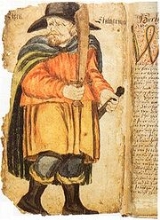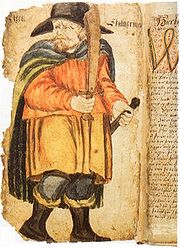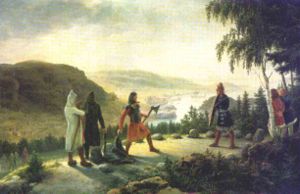
Egill Skallagrímsson
Encyclopedia

Viking Age
Viking Age is the term for the period in European history, especially Northern European and Scandinavian history, spanning the late 8th to 11th centuries. Scandinavian Vikings explored Europe by its oceans and rivers through trade and warfare. The Vikings also reached Iceland, Greenland,...
warrior and skald
Skald
The skald was a member of a group of poets, whose courtly poetry is associated with the courts of Scandinavian and Icelandic leaders during the Viking Age, who composed and performed renditions of aspects of what we now characterise as Old Norse poetry .The most prevalent metre of skaldic poetry is...
. Egill is one of the great anti-hero
Anti-hero
In fiction, an antihero is generally considered to be a protagonist whose character is at least in some regards conspicuously contrary to that of the archetypal hero, and is in some instances its antithesis in which the character is generally useless at being a hero or heroine when they're...
es of the Icelandic sagas.
Life
- The following is based on the Icelandic saga "Egils sagaEgils sagaEgils saga is an epic Icelandic saga. The oldest transcript dates back to 1240 AD. The saga is centered on the life of Egill Skallagrímsson, an Icelandic farmer, viking and skald...
"; like many sagasSagaSagas, are stories in Old Norse about ancient Scandinavian and Germanic history, etc.Saga may also refer to:Business*Saga DAB radio, a British radio station*Saga Airlines, a Turkish airline*Saga Falabella, a department store chain in Peru...
, it can be unreliable as a source of historical fact.

Iceland
Iceland , described as the Republic of Iceland, is a Nordic and European island country in the North Atlantic Ocean, on the Mid-Atlantic Ridge. Iceland also refers to the main island of the country, which contains almost all the population and almost all the land area. The country has a population...
, the son of Skalla-Grímr Kveldúlfsson
Skalla-Grímr
Skalla-Grímr Kveldulfsson was a Norwegian, who was forced to emigrate to Iceland in the days of his enemy Harald Fairhair. His main claim to fame is that he was the father of Egill, but he also deserves a footnote in the history of Nordic literature for having composed the following stanza:...
and Bera Yngvarsdóttir, and the grandson of Kveld-Úlfr ("Evening Wolf"). When Grímr arrived in Iceland, he settled at Borg, the place where his father's coffin landed. Grímr was a respected chieftain and mortal enemy of King Harald Fairhair of Norway
Norway
Norway , officially the Kingdom of Norway, is a Nordic unitary constitutional monarchy whose territory comprises the western portion of the Scandinavian Peninsula, Jan Mayen, and the Arctic archipelago of Svalbard and Bouvet Island. Norway has a total area of and a population of about 4.9 million...
.
Egill composed his first poem at the age of three years. He exhibited berserk behaviour, and this, together with the description of his large and unattractive head, has led to the theory that he might have suffered from Paget's disease
Paget's disease of bone
Paget's disease is a chronic disorder that can result in enlarged and misshapen bones. The excessive breakdown and formation of bone tissue causes affected bone to weaken, resulting in pain, misshapen bones, fractures, and arthritis in the joints near the affected bones...
. This is corroborated by an archeological find of a head from the Viking era which is likely to be Egill's.
At the age of seven, Egill was cheated in a game with local boys. Enraged, he went home and procured an axe, and returning to the boys, split the skull of the boy who cheated him, to the teeth. After Berg-Önundr refused to allow Egill to claim his wife Ásgerðr's share of her father's inheritance, he challenged Önundr to a holmgang
Holmgang
Holmgang was a duel practiced by early medieval Scandinavians. It was a recognized way to settle disputes....
.
Later, after being grievously insulted, Egill killed Bárðr of Atley, a retainer of King Eirik Bloodaxe and kinsman of Queen Gunnhildr, both of whom spent the remainder of their lives trying to take vengeance. Seething with hatred, Gunnhildr ordered her two brothers to assassinate Egill and his brother Þórólfr, who had been on good terms with her previously. However, Egill slew the Queen's brothers when they attempted to confront him.
That same summer, Harald Fairhair died. In order to secure his place as sole King of Norway, Eirik Bloodaxe murderered his two brothers. He then declared Egill an outlaw in Norway. Berg-Önundr gathered a company of men to capture Egill, but was killed in his attempt to do so. Before escaping from Norway, Egill also slew Rögnvaldr, the son of King Eirik and Queen Gunnhildr. He then cursed the King and Queen, setting a horse's head on a Nithing pole
Nithing pole
A nithing pole , sometimes normalized as nithstang or nidstang, was a pole used for cursing an enemy in Germanic pagan tradition.-History and usage:...
and saying,
- "Here I set up a níð-pole, and declare this níð against King Eiríkr and Queen Gunnhildr," — he turned the horse-head to face the mainland — "I declare this níð at the land-spirits there, and the land itself, so that all will fare astray, not to hold nor find their places, not until they wreak King Eiríkr and Gunnhildr from the land." He set up the pole of níð in the cliff-face and left it standing; he faced the horse's eyes on the land, and he carved runes upon the pole, and said all the formal words of the curse. (ch. 57).
Gunnhildr also put a spell on Egill, which made him feel restless and depressed until they met again.
Soon afterwards, Eiríkr and Gunnhildr were forced to flee to the Kingdom of Northumbria by Prince Hakon. In Saxon England, they were set up as King and Queen of Northumbria
Northumbria
Northumbria was a medieval kingdom of the Angles, in what is now Northern England and South-East Scotland, becoming subsequently an earldom in a united Anglo-Saxon kingdom of England. The name reflects the approximate southern limit to the kingdom's territory, the Humber Estuary.Northumbria was...
in rivalry with King Athelstan of England
Athelstan of England
Athelstan , called the Glorious, was the King of England from 924 or 925 to 939. He was the son of King Edward the Elder, grandson of Alfred the Great and nephew of Æthelflæd of Mercia...
. Ultimately, Egill was shipwrecked in Northumbria and came before Eiríkr's court, where he was promptly sentenced to death. However, Egill had already composed a drápa in Eiríkr's praise the night before. Therefore, when Egill recited it the King's presence, Eiríkr grudgingly allowed his mortal enemy to leave with his head still on his shoulders (see "Head Ransom", below).
Egill also fought at the Battle of Brunanburh
Battle of Brunanburh
The Battle of Brunanburh was an English victory in 937 by the army of Æthelstan, King of England, and his brother Edmund over the combined armies of Olaf III Guthfrithson, the Norse-Gael King of Dublin, Constantine II, King of Scots, and Owen I, King of Strathclyde...
in the service of King Athelstan.
Ultimately, Egill returned to his family farm in Iceland
Iceland
Iceland , described as the Republic of Iceland, is a Nordic and European island country in the North Atlantic Ocean, on the Mid-Atlantic Ridge. Iceland also refers to the main island of the country, which contains almost all the population and almost all the land area. The country has a population...
, where he remained a power to be reckoned with in local politics. He lived into his eighties and died shortly before Iceland converted to Roman Catholicism. Before Egill died he buried his silver
Silver
Silver is a metallic chemical element with the chemical symbol Ag and atomic number 47. A soft, white, lustrous transition metal, it has the highest electrical conductivity of any element and the highest thermal conductivity of any metal...
treasure near Mosfellsbær
Mosfellsbær
Mosfellsbær is a town in south-west Iceland, situated some east of the country's capital, Reykjavík. It has a total area of and its population as of September, 2011 was 8,886....
. In his last act of violence he murdered the servant who helped him bury his treasure.
When a Roman Catholic chapel
Chapel
A chapel is a building used by Christians as a place of fellowship and worship. It may be part of a larger structure or complex, such as a church, college, hospital, palace, prison or funeral home, located on board a military or commercial ship, or it may be an entirely free-standing building,...
was constructed at the family homestead, Egill's body was re-exumed by his son and re-buried near the altar
Altar (Catholicism)
In the liturgy of the Roman Catholic Church, the altar is where the Sacrifice of the Mass is offered. Mass may sometimes be celebrated outside a sacred place, but never without an altar, or at least an altar stone.-Precedent:...
.
Issue
Egill had five children with Ásgerðr Björnsdóttir: Þorgerðr EgilsdóttirThorgerd Egilsdottir
Thorgerd Egilsdottir was an Icelandic woman of the tenth century. She was the daughter of Egill Skallagrímsson and the wife of Olaf the Peacock. Olaf and Thorgerd had a number of children: the sons Kjartan, Steinthór, Halldór, Helgi, and Höskuldur and the daughters Thurídur, Thorbjörg, Thorgerd...
, Bera Egilsdóttir, Böðvar Egilsson, Gunnar Egilsson and Þorsteinn Egilsson. In later years, Iceland's Myrar clan
Clan
A clan is a group of people united by actual or perceived kinship and descent. Even if lineage details are unknown, clan members may be organized around a founding member or apical ancestor. The kinship-based bonds may be symbolical, whereby the clan shares a "stipulated" common ancestor that is a...
claimed descent from him.
Poems
Apart from being a warrior of immense might in literary sources, Egill is also celebrated for his poetry, considered by many historians to be the finest of the ancient Scandinavian poetry and SonatorrekSonatorrek
Sonatorrek is a skaldic poem in 25 stanzas by Egill Skallagrímsson . The work laments the death of two of the poet's sons, Gunnar, who died of a fever, and Böðvarr, who drowned during a storm. It is preserved in Egils saga Skalla-Grímssonar, ch. 78, which is included in the 14th-century...
, the dirge over his own son, has been called "the birth of Nordic personal lyric poetry". His poems were also the first Old Norse verses to use end rhyme. The following works are attributed to Egill:
- Aðalsteinsdrápa. Drápa for the Anglo-Saxon King ÆthelstanAthelstan of EnglandAthelstan , called the Glorious, was the King of England from 924 or 925 to 939. He was the son of King Edward the Elder, grandson of Alfred the Great and nephew of Æthelflæd of Mercia...
. - HöfuðlausnHöfuðlausnHöfuðlausn or the "Head's Ransom" is a skaldic poem attributed to Egill Skalla-Grímsson in praise of king Eirik Bloodaxe.It is cited in Egils Saga , which claims that he created it in the span of one night. The events in the saga that lead up to the composition and recitation of the poem can be...
("The Head Ransom", sometimes referred to as "Head-Ransom"), with which Egill bought his life from Eiríkr Bloodaxe, who had sentenced him to death in EnglandEnglandEngland is a country that is part of the United Kingdom. It shares land borders with Scotland to the north and Wales to the west; the Irish Sea is to the north west, the Celtic Sea to the south west, with the North Sea to the east and the English Channel to the south separating it from continental...
. - SonatorrekSonatorrekSonatorrek is a skaldic poem in 25 stanzas by Egill Skallagrímsson . The work laments the death of two of the poet's sons, Gunnar, who died of a fever, and Böðvarr, who drowned during a storm. It is preserved in Egils saga Skalla-Grímssonar, ch. 78, which is included in the 14th-century...
("The Loss of a Son"). After the death of his son Böðvar who drowned during a storm. - ArinbjarnarkviðaArinbjarnarkviðaArinbjarnarkviða is a skaldic poem by Egill Skalla-Grímsson in praise of his friend Arinbjörn. The poem is preserved in manuscripts of Egils saga. Some lines are lost while others may be corrupted. The metre is kviðuháttr.-References:...
. Dedicated to his companion Arinbjörn - Skjaldardrápa.
- Berudrápa.
- Lausavísur.
- Fragments
The following is one of Egill's Lausavísur (no. 3), found in chapter 40 of Egils Saga:
|
|
|
Runes
Egill was also a scholar of runes. His apparent mastery of their magic powers assisted him several times during his journeys. During a feast at Atla-isle, Bard's attempt to poison Egill failed when a rune carved by Egill shattered his poisoned cup. Runes were also employed by Egill during the raising of the Nithing Pole against King Eirik Bloodaxe and Queen Gunnhildr.At a companion's request, he examined a sick woman. A local land owner, after being denied her hand in marriage, had attempted to carve love-runes. Instead, he had mistakenly carved runes causing illness. Egill burned the offending runes and carved runes for health, and the woman recovered. He then sang a poem declaring that "Runes none should grave ever/Who knows not to read them."
Egill in popular culture
- Egill remains a very popular figure in Iceland, with a beer brewery, Ölgerðin Egill Skallagrímsson, named after him.
- Some people pertaining to the ÁsatrúÁsatrúis a form of Germanic neopaganism which developed in the United States from the 1970s....
religion consider Egill a true hero and hold a day of remembrance for him on December 9. - There is a talk show on Icelandic television called Egill's Silver, named after Egill's hidden treasure. This, however, was also a double joke, since the host's first name is Egill.
- "Egill's Silver" is also the name of a song by MegasMegasMegas , is a rock and roll singer, songwriter and writer who is well-known in his native country of Iceland.-Interest in music:...
, from his first albumMegas (album)Megas was is the first album by Icelandic rock singer Magnús Þór Jónsson .The original album released in 1972 has 15 songs and was released on CD in 1994. The 2002 remastered reissue has 7 bonus tracks, demos and live recordings. Most of the bonus tracks have not been released on any other album...
. - In the SCASociety for Creative AnachronismThe Society for Creative Anachronism is an international living history group with the aim of studying and recreating mainly Medieval European cultures and their histories before the 17th century...
Barony of Adiantum there is an "Egil Skallagrimsson Memorial Tournament" held annually on memorial day weekend. - The novelist Poul AndersonPoul AndersonPoul William Anderson was an American science fiction author who began his career during one of the Golden Ages of the genre and continued to write and remain popular into the 21st century. Anderson also authored several works of fantasy, historical novels, and a prodigious number of short stories...
(a member of the SCA) wrote Mother of KingsMother of KingsMother of Kings is a historical novel by Poul Anderson. It was first published in 2001 by Tor Books. The book is an account of the life of Gunnhild, Mother of Kings, a tenth-century queen of Norway and wife of King Eirik Bloodaxe. It is based largely on the accounts of Gunnhild's life given in...
, a historical fantasy centered on Gunnhildr and the long feud that she, Eirikr, and their children had with Egill. The novel is based on HeimskringlaHeimskringlaHeimskringla is the best known of the Old Norse kings' sagas. It was written in Old Norse in Iceland by the poet and historian Snorri Sturluson ca. 1230...
and Egils SagaEgils sagaEgils saga is an epic Icelandic saga. The oldest transcript dates back to 1240 AD. The saga is centered on the life of Egill Skallagrímsson, an Icelandic farmer, viking and skald...
.
Sources
- Jansson, Sven B. (1980). Runstenar. STF, Stockholm. ISBN 91-7156-015-7
- Palsson, Hermann and Edwards, Paul (Translators), Egil's Saga 1976, Penguin Classics
External links
- Poems, Skaldic Poetry of the Scandinavian Middle Ages.
In English
English language
English is a West Germanic language that arose in the Anglo-Saxon kingdoms of England and spread into what was to become south-east Scotland under the influence of the Anglian medieval kingdom of Northumbria...
:
- Egil's saga - English translation (W. C. Green) at the Icelandic Saga Database, with original Old Norse and Icelandic text
- Egil Skallagrimsson and the Viking Ideal by Christina von Nolcken, from a University of ChicagoUniversity of ChicagoThe University of Chicago is a private research university in Chicago, Illinois, USA. It was founded by the American Baptist Education Society with a donation from oil magnate and philanthropist John D. Rockefeller and incorporated in 1890...
website - Egil's Bones, from a University of California, Los AngelesUniversity of California, Los AngelesThe University of California, Los Angeles is a public research university located in the Westwood neighborhood of Los Angeles, California, USA. It was founded in 1919 as the "Southern Branch" of the University of California and is the second oldest of the ten campuses...
website - Text of the saga, translated into English by Rev. W. C. Green in 1893, from the Northvegr Foundation
In
 Icelandic
IcelandicIcelandic language
Icelandic is a North Germanic language, the main language of Iceland. Its closest relative is Faroese.Icelandic is an Indo-European language belonging to the North Germanic or Nordic branch of the Germanic languages. Historically, it was the westernmost of the Indo-European languages prior to the...
:
- Egils saga -- Text of Egils saga at the Icelandic Saga Database, modern spelling and Old Norse version
- Text of Egill's saga, with modern spelling
- Höfundur Egill Skallagrímsson

